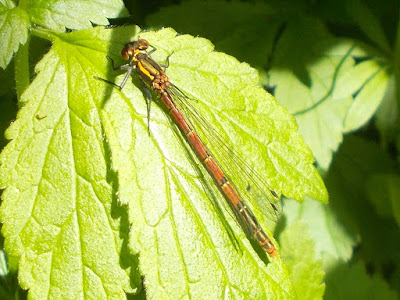 |
Looking north across 'Meadow X'. Daventry. 7 May, 2020
|
Most of these trees have doubtless been planted but they are maturing nicely and include many features of interest. In these 'lockdown days' the A45 is rather quiet but normally carries a great deal of heavy traffic, so these trees provide a valuable baffle against the noise.
 |
The catkins on oaks are now withering. Meadow X, Christchurch Road,
Daventry. 7 May, 2020
|
The oaks are inevitably of wildlife value although some of them are the less useful Turkey Oak, Quercus cerris. The catkins of the oaks have now withered, their task complete, but here and there they bear currant-like galls. These are work of a tiny wasp, Neuroterus quercusbaccarum. It has two generations, with the alternating generation producing galls of a quite different kind.
 |
Oak Currant Galls can be abundant in some years.
Meadow X, Christchurch Road, Daventry. 7 May, 2020
|
Another wasp species is responsible for a familiar gall noted today, again on oak. This is the classic oak apple, and the wasp involved is Biorhiza pallida. It often has a rather lumpy structure and may be almost golf ball size.
 |
Not exactly a pretty sight. An oak apple at the edge of Meadow X.
7 May, 2020
|
Leaves on the beech trees were also galled but in a far less obvious way. The galled leaf edges have a neat little rim, easily overlooked. These have been caused by a quite different creature, a mite called Acalitus stenapsis.
 |
A neat little rim on beech leaves is the work of a mite, Aculitis stenapsis.
Woodland at edge of Christchurch Drive, Daventry. 7 May, 2020
|
Back to the oaks. Running over the withering catkins were many specimens of a bug (a true bug, that is) called Harpocera thoracica. It is very common but they are short-lived in the adult stage so, unless I remember to look for them at this time of the year, I do not often see them. They are about 5-6 mm long.
 |
Harpocera thoracica seems to be found only on oak. Meadow X,
Daventry. 7 May, 2020
|
I passed my sweep net over some hawthorns and once again caught a specimen of the bright red weevil, Rhynchites aequatus. Its natural home seems to be on hawthorns but, as I have written in a previous blog, it is partial to apple, boring into the flesh with its long rostrum - much to the annoyance of orchardists. It is, in fact, known as the Apple Fruit Weevil.
 |
Rhynchites aequatus is very common on hawthorn at this time of the year.
Meadow X., Daventry. 7 May, 2020
|
Wandering back towards my home I was pleased to see a damsel fly on a plant of Wood Avens. It is called, quite reasonably, the Large Red Damselfly, Pyrrhosoma nymphula, (pyrrhosoma translates as 'red bodied') and, as far as I know, is the only red damselfly found in Northamptonshire. Although these insects need water to breed they are, as in this case, often found at some distance from an obvious lake or river.
 |
Large Red Damselfly on Wood Avens, Geum urbanum.
7 May, 2020
|
There were many small flies out enjoying the warm sunshine and I'll be busy at my microscope for a few hours identifying them. (Well, as I've said before, someone has to do it.)
No comments:
Post a Comment